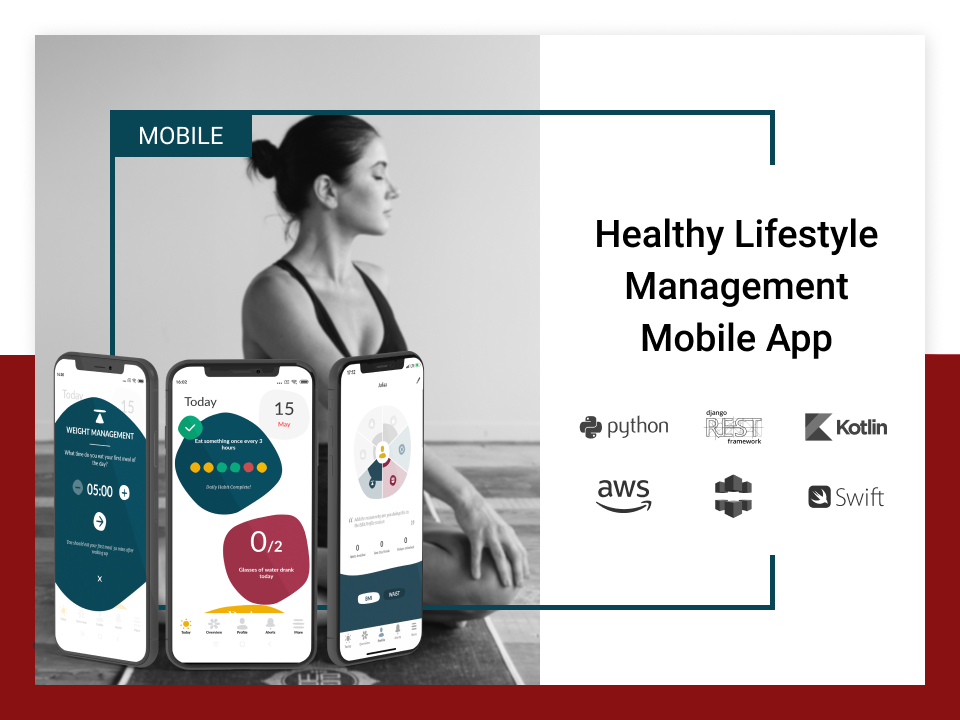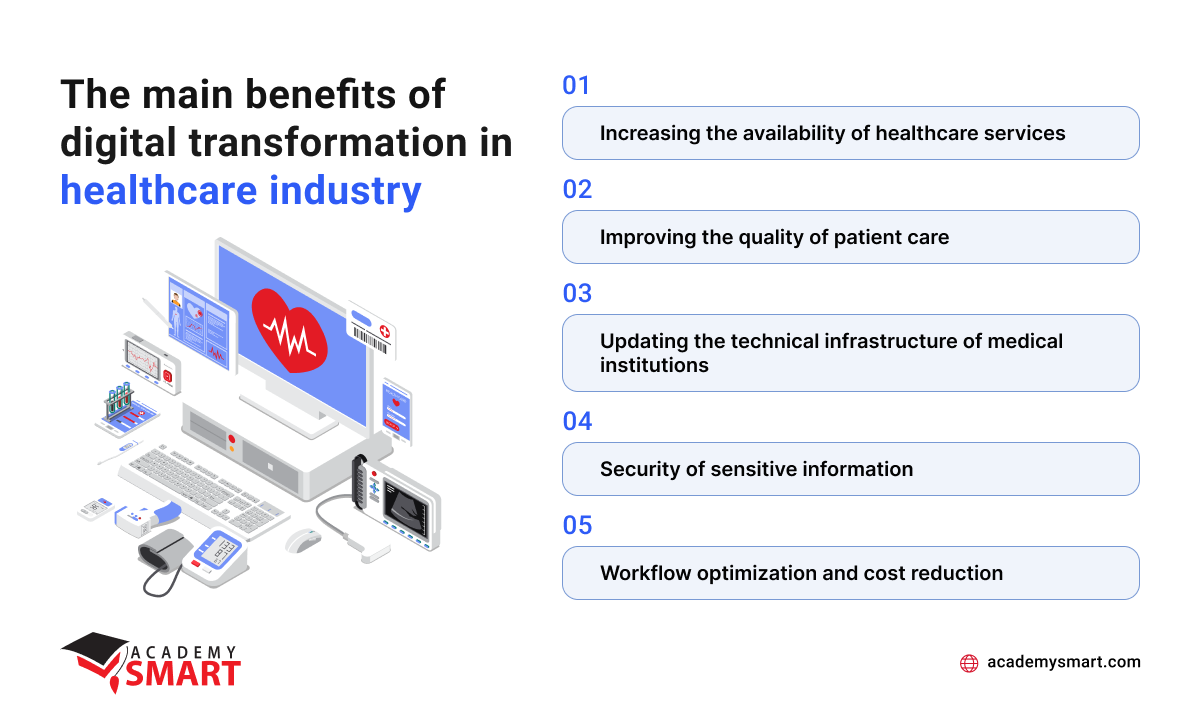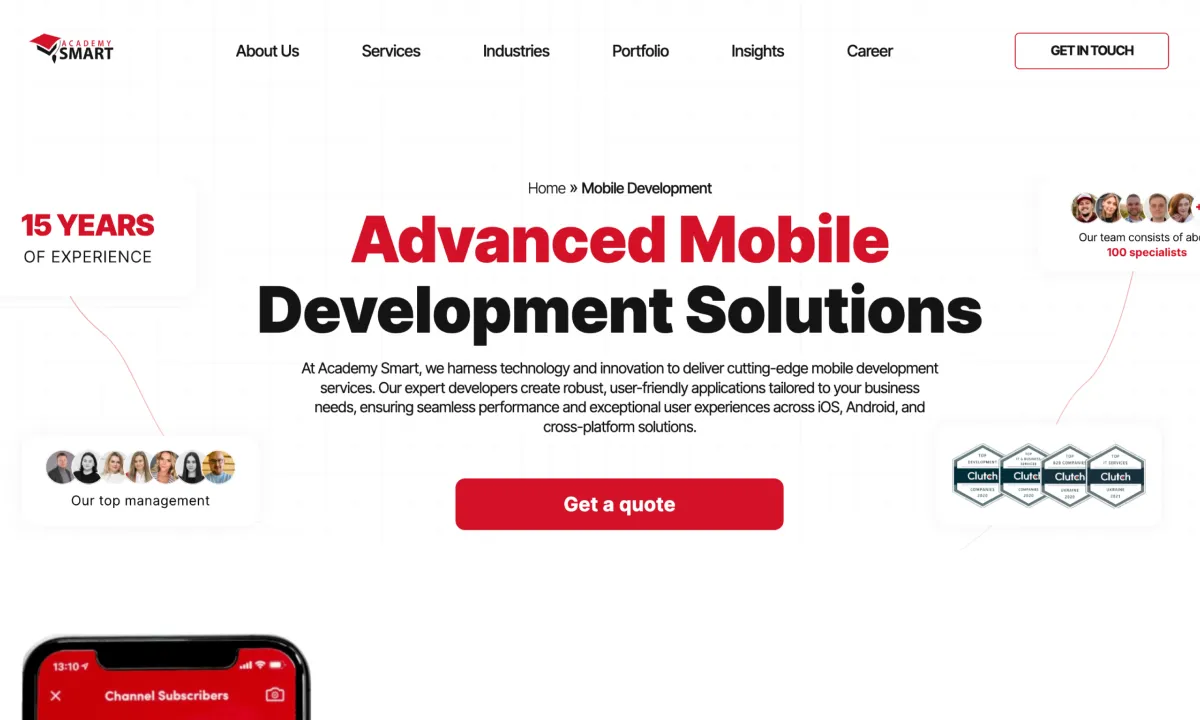
Digital Transformation in Healthcare: 5 Benefits
Contents
Medicine today is the industry that is most actively experiencing the processes of digitalization and saturation with new-generation technical means. No one is surprised anymore by the electronic patient record, which has replaced outdated paper documentation, electronic appointments or remote examinations through mobile apps, and vital signs sensors on smart devices. Moreover, the healthcare industry is increasingly using the most advanced technical solutions in Big data, artificial intelligence, and augmented reality to accumulate, process, and deeply analyze clinical data and transfer professional knowledge.
Of course, a modern medical enterprise or wellness lifestyle-related business must pay due attention to the healthcare digital transformation to remain profitable and competitive. This article will introduce you to the leading trends of change in the industry and help you decide on the choice of priority investments for your case.
What is Digital Transformation in Healthcare
Digital transformation in healthcare industry is the comprehensive process of upgrading modern medicine’s entire communication and technical systems and services by adopting information technologies and innovative approaches. It goes beyond simply using computers and robotic solutions and involves multiple changes across various aspects of the healthcare sector.
The timeliness for digital transformation in the medical area arises from three main reasons:
- The technological base of modern IT already makes it possible to create, maintain, and analytically process vast digital arrays of medical knowledge and clinical data, providing essential support to doctors in diagnosing and treating diseases.
- The world has witnessed pandemic experiences in recent years, placing additional strain on healthcare providers.
- The aging population in developed countries is increasing, leading to a higher demand for medical attention and serviceability.
But what is digital transformation in healthcare de facto, and what is it needed for? Digital transformation aims to enhance the effectiveness of the healthcare system, remove bottlenecks, and expedite medical processes to deliver high-quality care more efficiently.
By making the healthcare system more effective, digital transformation benefits healthcare providers and patients. Providers invest in adopting new technologies and approaches to improve their services, while innovators seize the opportunity to offer unique medical solutions. Governments and big medical enterprises are crucial in prioritizing and planning the implementation of digital transformation in healthcare, ensuring proper control and funding.
The vast potential benefits and profitability of digital transformation attract investors and startups to invest in this evolving sector. By simplifying management, reducing paperwork and unnecessary expenses, and facilitating telemedicine and remote consultations, digitalization transforms the healthcare industry, making it more flexible and accessible to patients and healthcare professionals alike. The portfolio presentation provides examples to explore efficient healthcare applications our team created for our customers.
Healthcare Digital Transformation: trends and examples
Healthcare digital transformation has emerged as a powerful strategy with immense potential now. As statistics indicate, many internet users seek health-related information and solutions online, driving a massive influx of searches daily. This growing interest in digital possibilities in medicine opens up numerous promising trends in the context of medical services. Let’s explore some of the most impactful examples of healthcare digitization practice, shaping the future of medical care and patient experiences.
Digitization of medical knowledge and data
The digitization of medical knowledge and data stands at the forefront of the digital transformation revolutionizing the healthcare industry. This trend involves the conversion of traditional patient charts and medical records into electronic medical records (EMR), creating extensive and secure databases. These databases store a wealth of information, from personal health records to medical research outcomes and clinical trial results, facilitating access to critical information by diversified specialists for more detailed diagnosis and selecting the right strategy for treating the patient.
By harnessing computer technology, healthcare institutions can now establish sophisticated Healthcare Information Systems (HIS) that automate routine processes, optimize business operations, and enhance the overall quality of medical services. From improving clinic management and patient records maintenance to simplifying interactions with government authorities and insurance services, the digitization of medical knowledge and data plays a pivotal role in changes of modern healthcare.
Big data and artificial intelligence
Integrating big data and AI is expected to shape a new era of patient-centric care. By harnessing the power of these technologies, healthcare providers can unlock valuable insights, optimize operations, and ultimately improve patient outcomes.
Analytics and research are among the most promising applications of Big data in healthcare. By tapping into the power of cloud computing, healthcare providers can now process and analyze massive datasets at unprecedented speeds. This capability allows researchers to identify patterns, trends, and correlations in medical data that were previously hidden, leading to breakthroughs in understanding diseases and designing more effective treatments.
Moreover, Big data analytics can transform patient care by enabling personalized medicine. With access to a comprehensive view of a patient’s medical history, genetics, and lifestyle, healthcare professionals can tailor treatments and interventions to the individual’s specific needs. This personalized approach improves patient outcomes and reduces unnecessary procedures and costs.
Artificial intelligence also serves as a game-changer in healthcare by enhancing decision-making, diagnostics, and patient engagement. AI algorithms, powered by machine learning, can process vast amounts of medical data with remarkable speed and accuracy, aiding in the early detection of diseases and guiding treatment plans.
AI-powered chatbots and virtual assistants are also integrated into healthcare services, providing patients with accessible and personalized support. For instance, mental health chatbots like Wysa offer therapeutic assistance for depression, anxiety, and stress, providing individuals with a readily available and non-judgmental resource to manage their mental well-being.
Furthermore, AI can assist doctors in diagnosing complex conditions by analyzing medical images and test results. AI’s ability to detect subtle patterns and abnormalities can serve as a valuable tool in early disease detection and prompt treatment.
Web & mobile healthcare applications
Web and mobile healthcare applications have emerged as a significant trend in the digital transformation of medicine, offering new possibilities for both patients and healthcare providers. These apps go beyond the traditional patient-doctor interaction, optimizing healthcare processes, increasing patient engagement, and improving healthcare quality. They cater to patients’ changing needs and expectations, who seek high-quality healthcare services, personalized approaches, and easy access to medical information. Healthcare mobile apps have become a valuable tool for pharmaceutical companies, improving the efficiency of medical representatives, facilitating communication between doctors and patients, and providing timely and relevant information for decision-making.
Telemedicine apps, for example, have got growth, especially during the COVID-19 pandemic. They leverage computer and telecommunication technologies to deliver remote consultations, diagnostics, treatment, and monitoring, breaking distance barriers and enhancing access to medical care. Telemedicine applications enable real-time communication between patients and doctors through video conferences, allowing for medical sessions anywhere and exchanging text or graphic data. This approach has proven invaluable in various medical fields, such as pediatrics, psychotherapy, dermatology, and neurology.
The possibility to communicate Internet of Things (IoT) devices with healthcare applications is revolutionizing how health-related data is collected and utilized. Smart devices like fitness trackers may continuously gather personal health information, such as heart rate, sleep patterns, and stress levels. When coupled with well-designed software, this data can be used for various purposes, from adding to digital health records to diagnosing illnesses and devising personalized exercise routines or diets. IoT’s implementation in telemedicine solutions has also allowed for convenient appointment booking and doctor consultations through mobile applications, eliminating the need for physical visits to healthcare facilities.
Building web and mobile healthcare applications requires medical experts and IT developers’ collaboration. But, their creation and support need unique technical expertise in-house, which is quite expensive to maintain permanently. However, today it is easy and comfortable to establish remote interaction with an outsourced technical team or outstaffing employees to develop the app and its further support. And with the choice of offshore service providers, the opportunity to save on digital transformation in healthcare industry reduces the burden on the enterprise budget.
Augmented and virtual reality technologies
Augmented and virtual reality (AR/VR) technologies also impact medical practice and patient care. VR technology offers new possibilities for medical training, surgical simulations, and treating mental and physical disorders, providing immersive and engaging experiences for both medical professionals and patients.
One of the significant applications of AR/VR in healthcare is improving the patient experience. These technologies enhance patient engagement and comfort with features like pop-up information, navigation aids, and communication tools for better interactions between patients and healthcare providers. AR/VR can also be used for psychological relief and therapy, such as pain reduction, sleep improvement, and treating mental conditions like anxiety and phobias.
Data visualization and body mapping are other valuable applications of AR/VR in healthcare. These technologies enable doctors to visualize patient data and vital stats directly on the patient’s body, simplifying complex information and aiding in diagnostics and treatment planning. Additionally, AR/VR can play a crucial role in advanced diagnostics and risk assessment by providing doctors with live stats, visualizing potential causes of a patient’s condition, and improving precision in diagnosis.
AR/VR solutions are also invaluable in medical education and training. Through VR training, medical students can study human anatomy in-depth and gain a profound understanding of body functions. Simulation scenarios in VR help trainees practice medical procedures and improve their skills more engagingly.
Bionics and robotics
Bionics and robotics represent a groundbreaking trend in the digital transformation of healthcare, where engineering and software development merge to restore and enhance human body functionality. This multifaceted field encompasses a range of solutions, from simple RFID chips to sophisticated pacemakers, experimental bionic eyes, and complex robotic prostheses and exoskeletons. These advancements rely on algorithms, sensors, processors, and other technologies to create a seamless interface between the human nervous system and automatic body parts.
Of course, we will see the full results of the digital transformation of the industry, and especially its knowledge-intensive fields, only over time. However, it is already possible today to create functional and profitable apps for everyday health care tasks. An application for organizing a healthy lifestyle is also one of the particular trends of our time.

Healthcare digital transformation example
5 benefits of Digital Transformation in Healthcare industry
Innovative technologies and software solutions have opened up new horizons for medical providers. But, a skilled team of healthcare app developers is needed to unlock the potential of digital transformation in medicine fully. Their expertise and collaboration with medical professionals ensure the benefits of digital transformation are harnessed to drive improvements in patient care, cost-effectiveness, and overall operational efficiency.
1. Increasing the availability of healthcare services
Digital transformation increases the availability of healthcare services to a broader population in different ways.
This process optimizes administrative activity, reducing wait times, paperwork, and bureaucratic hurdles. Electronic health records (EHRs) ensure patient information is readily accessible to authorized healthcare providers, promoting seamless continuity of care and reducing duplication of tests or procedures.
Mobile healthcare applications have become a prominent avenue to deliver wellness services directly to patients’ smartphones. These apps offer various functionalities, such as scheduling appointments, accessing medical records, or monitoring health metrics. By facilitating remote communication and empowering patients with information and self-care tools, these apps enhance accessibility and encourage proactive healthcare management.
Enabled by digital advancements, telemedicine has emerged as a powerful tool in expanding healthcare access. Patients can connect with healthcare professionals regardless of geographical location through video consultations and remote monitoring. Additionally, IoT-enabled wearable devices allow real-time tracking of vital signs and health parameters. This constant stream of data helps healthcare professionals get patient states and respond promptly to any concerning trends, improving overall patient outcomes.
The availability of online healthcare platforms and information databases has empowered individuals to access medical knowledge and seek reliable information about their health state. These resources provide insights into symptoms, treatments, and preventive measures, enabling patients to make informed decisions and participate actively in their healthcare journey.
2. Improving the quality of patient care
The digital transformation in medicine has a profound impact on improving the quality of patient care.
With the help of video consultations and virtual visits, patients can connect with healthcare professionals from the comfort of their homes. This approach is particularly advantageous for individuals with limited mobility, those living in remote areas, or those facing travel constraints. Remote examinations allow for timely assessments, early detection of health issues, and proactive interventions, ultimately improving patient outcomes.
Accurate diagnosis is another area significantly impacted by digital transformation. Advanced diagnostic tools powered by artificial intelligence and machine learning algorithms aid doctors in interpreting medical imaging, analyzing pathology samples, and identifying patterns in patient data. These technologies allow physicians to make more precise and timely diagnosis, leading to tailored therapy plans and improved prognosis.
Additionally, the healthcare digital transformation has led to the development of predictive analytics. By analyzing vast amounts of patient data, predictive analytics can identify trends and risk factors, allowing healthcare professionals to intervene proactively and prevent potential health complications.
Digital transformation also facilitates fast data transfer and seamless communication between specialists. Electronic health records (EHRs) enable real-time access to clinical information, ensuring that all healthcare team members are informed and up-to-date on the patient’s condition and treatment history. This collaborative approach promotes coordinated care, reduces medical errors, and streamlines decision-making, ultimately benefiting the patient.
In surgical settings, digital technologies have increased the speed and precision of operations. Surgeons can employ advanced robotic-assisted tools and surgical navigation systems to enhance their capabilities. It provides greater accuracy, less invasive procedures, and shorter patient recovery times.
3. Updating the technical infrastructure of medical institutions
Usually, the first step in updating the technical infrastructure of a medical organization is implementing electronic health records (EHRs). Moving from traditional paper-based documents to digital systems streamlines data management and storage. EHRs enable healthcare providers to access patient information instantaneously, reducing the risk of errors and ensuring continuity of care. Digitizing medical records also improves the security and confidentiality of sensitive patient data.
Another aspect involves the utilization of advanced medical devices and equipment. Modern diagnostic tools, imaging systems, and monitoring devices provide healthcare professionals with more accurate and detailed data, leading to more precise diagnoses and better treatment decisions. Furthermore, updating the technical infrastructure enables medical institutions to implement data analytics and AI-powered solutions. These technologies can help to identify trends, predict patient outcomes, and optimize clinical workflows. Insights derived from data analytics support evidence-based decision-making and drive continuous improvement in medical practices.
Collaboration within medical institutions also extends. Integrating video conferencing tools and secure messaging systems allows for seamless communication between healthcare professionals, promoting interdisciplinary cooperation and knowledge sharing.
4. Security of sensitive information
By prioritizing the security of sensitive information, digital transformation in the healthcare industry establishes trust between patients and medicine service providers. Today, organizations provide secure access to personal health information through patient portals and mobile healthcare applications. Patients can confidently manage their health records, knowing their data remains private and protected.
With the shift from paper-based to electronic health records (EHRs), patient data is now stored in secure, encrypted databases. Advanced cybersecurity technologies, including robust firewalls, intrusion detection systems, and encryption protocols, are implemented to prevent data breaches and cyberattacks, ensuring patient privacy.
Furthermore, compliance with industry standards is a crucial aspect of data security. Medical institutions have to adhere to stringent regulations such as HIPAA (Health Insurance Portability and Accountability Act) to protect patient information. Regular security audits and vulnerability assessments are conducted to identify and address potential weaknesses in the system, maintaining the highest data protection standards.
5. Workflow optimization and cost reduction
Electronic health records and automated systems replace time-consuming manual tasks with faster and more accurate processes. It allows medical professionals to focus on patient care, diagnosis, and treatment rather than being bogged down by paperwork and administrative duties.
By implementing digital inventory management systems, medical facilities can track supplies in real-time, minimizing overstocking and avoiding shortages. Digital platforms and tools are accelerating test and diagnostic results, making them cheaper and freeing time to make better decisions.
By embracing innovative technologies and digital solutions, healthcare institutions streamline their processes, reducing the burden on staff and enhancing overall efficiency. These cost savings can be reinvested in improving patient care, expanding services, and further technological advancements.

The main benefits of digital transformation in healthcare industry
How Academy SMART can help you
The success of the digital transformation is largely ensured by an experienced and reliable partner who is ready to take responsibility for the technical side of the process and is well acquainted with the specifics of the healthcare industry.
The Academy Smart’s team offers high-quality assistance in assessing the digitization activities of your medical enterprise, choosing the optimal technical stack, and developing web- and cloud-based applications for various purposes and levels of complexity. Of course, you will find talented and skilled programmers and project managers with us to expand your internal teams or outsource turnkey software development.
We know how to organize the healthcare digital transformation process more easily, efficiently, and cheaply. Contact us for a detailed discussion of your business goals.
Digital Transformation in Healthcare industry: Frequently Asked Questions
What are the main components of Digital Transformation in Healthcare?
The main components of digital transformation in healthcare include innovative technologies and IT solutions to optimize clinical processes and enhance patient care.
How Digital Transformation is driving action in Healthcare?
Digital transformation is leading to changes in how medical services are provided, using technology to improve patient outcomes, organizing clinical data and workflows, professional communication and knowledge sharing, diagnosis, and healing procedures.
Book a free consultation

Reach out to start talking today!











